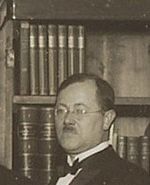Wander Johannes de Haas facts for kids
Quick facts for kids
W. J. de Haas
|
|
|---|---|

De Haas in 1925
|
|
| Born | 2 March 1878 Lisse, Netherlands
|
| Died | 26 April 1960 (aged 82) Bilthoven, Netherlands
|
| Alma mater | University of Leiden |
| Known for | De Haas–Van Alphen effect Shubnikov–de Haas effect Einstein–de Haas effect |
| Awards | Rumford Medal (1934) |
| Scientific career | |
| Fields | Physicist |
| Institutions | University of Leiden TU Delft |
| Doctoral advisor | Heike Kamerlingh Onnes |
| Other academic advisors | Johannes Petrus Kuenen |
| Doctoral students | Cornelis Jacobus Gorter Gerardus J. Sizoo |
| Notes | |
|
He was the husband of Geertruida Luberta Lorentz and the son-in-law of Hendrik Lorentz.
|
|
Wander Johannes de Haas (born March 2, 1878, died April 26, 1960) was a famous Dutch scientist. He was both a physicist, who studies how the world works, and a mathematician, who works with numbers and patterns. He is especially known for discovering three important physics effects: the Shubnikov–de Haas effect, the De Haas–Van Alphen effect, and the Einstein–de Haas effect. These effects help us understand how materials behave in strong magnetic fields and at very cold temperatures.
Contents
Early Life and Family
Wander de Haas was born in Lisse, a small town in the Netherlands, close to Leiden. His father, Albertus de Haas, was the principal of a teacher's college. His mother was Maria Efting.
On December 22, 1910, Wander de Haas married Geertruida Luberta Lorentz. She was the oldest daughter of Hendrik Lorentz, a very famous physicist who won the Nobel Prize. Wander and Geertruida had four children: two daughters and two sons.
Becoming a Scientist
De Haas went to high school in Middelburg. After high school, he started studying law in 1895. He even worked in a lawyer's office for a while. However, he soon realized that law was not his true passion. He decided to change his career and become a physicist instead!
In 1900, after passing special exams to get into university, he began studying physics at the University of Leiden. He learned from two important professors: Heike Kamerlingh Onnes and Johannes Petrus Kuenen. Kamerlingh Onnes was a pioneer in studying things at extremely low temperatures.
De Haas earned his doctorate degree in 1912. His research focused on how hydrogen gas could be compressed.
Working as a Physicist
After finishing his studies, De Haas worked as a researcher in Berlin, Germany. Later, he returned to the Netherlands. He worked as a schoolteacher in Deventer and as a conservator (someone who takes care of collections) at the Teylers Museum in Haarlem.
He then became a physics professor at the Delft Technical School and later at the University of Groningen. In 1925, he moved back to Leiden and became a professor at the University of Leiden. He also became one of the leaders of the physics laboratory there, taking over from his former teacher, Kamerlingh Onnes.
De Haas retired from his work in 1948.
Important Discoveries
Wander de Haas is famous for his work with very cold temperatures and strong magnetic fields. He helped discover several important effects:
- Shubnikov–de Haas effect: This effect describes how the electrical resistance of a material changes in a strong magnetic field at very low temperatures. It helps scientists understand the tiny particles (electrons) inside materials.
- De Haas–Van Alphen effect: This effect shows how the magnetic properties of a material change in a strong magnetic field. It's also used to study the behavior of electrons.
- Einstein–de Haas effect: This effect shows a connection between magnetism and the spinning motion of objects. It proved that magnetism is caused by the spin of electrons. He worked on this with Albert Einstein!
Some of the special equipment he used for his low-temperature research, like a large electromagnet from the 1930s, can still be seen today. It is displayed at the Boerhaave Museum in Leiden, which is a museum about the history of science.
Royal Academy Membership
In 1922, Wander de Haas became a member of the Royal Netherlands Academy of Arts and Sciences. This is a very important group of top scientists and artists in the Netherlands.
However, in 1942, during World War II, he had to leave the Academy. After the war ended in 1945, he was allowed to rejoin as a member.
See also
 In Spanish: Wander Johannes de Haas para niños
In Spanish: Wander Johannes de Haas para niños

